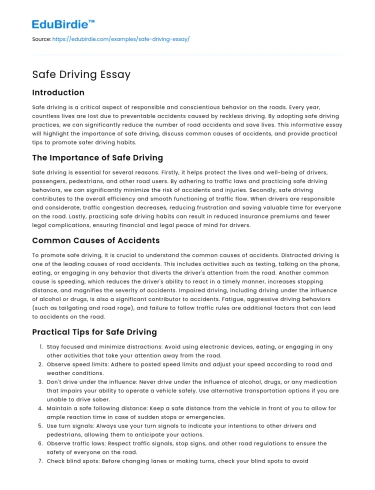Introduction
Safe driving is a critical aspect of responsible and conscientious behavior on the roads. Every year, countless lives are lost due to preventable accidents caused by reckless driving. By adopting safe driving practices, we can significantly reduce the number of road accidents and save lives. This informative essay will highlight the importance of safe driving, discuss common causes of accidents, and provide practical tips to promote safer driving habits.
The Importance of Safe Driving
Safe driving is essential for several reasons. Firstly, it helps protect the lives and well-being of drivers, passengers, pedestrians, and other road users. By adhering to traffic laws and practicing safe driving behaviors, we can significantly minimize the risk of accidents and injuries. Secondly, safe driving contributes to the overall efficiency and smooth functioning of traffic flow. When drivers are responsible and considerate, traffic congestion decreases, reducing frustration and saving valuable time for everyone on the road. Lastly, practicing safe driving habits can result in reduced insurance premiums and fewer legal complications, ensuring financial and legal peace of mind for drivers.
Save your time!
We can take care of your essay
- Proper editing and formatting
- Free revision, title page, and bibliography
- Flexible prices and money-back guarantee
Common Causes of Accidents
To promote safe driving, it is crucial to understand the common causes of accidents. Distracted driving is one of the leading causes of road accidents. This includes activities such as texting, talking on the phone, eating, or engaging in any behavior that diverts the driver's attention from the road. Another common cause is speeding, which reduces the driver's ability to react in a timely manner, increases stopping distance, and magnifies the severity of accidents. Impaired driving, including driving under the influence of alcohol or drugs, is also a significant contributor to accidents. Fatigue, aggressive driving behaviors (such as tailgating and road rage), and failure to follow traffic rules are additional factors that can lead to accidents on the road.
Practical Tips for Safe Driving
- Stay focused and minimize distractions: Avoid using electronic devices, eating, or engaging in any other activities that take your attention away from the road.
- Observe speed limits: Adhere to posted speed limits and adjust your speed according to road and weather conditions.
- Don't drive under the influence: Never drive under the influence of alcohol, drugs, or any medication that impairs your ability to operate a vehicle safely. Use alternative transportation options if you are unable to drive sober.
- Maintain a safe following distance: Keep a safe distance from the vehicle in front of you to allow for ample reaction time in case of sudden stops or emergencies.
- Use turn signals: Always use your turn signals to indicate your intentions to other drivers and pedestrians, allowing them to anticipate your actions.
- Observe traffic laws: Respect traffic signals, stop signs, and other road regulations to ensure the safety of everyone on the road.
- Check blind spots: Before changing lanes or making turns, check your blind spots to avoid collisions with vehicles or motorcycles that may not be visible in your mirrors.
- Buckle up and secure passengers: Ensure that all occupants of the vehicle are wearing seatbelts or are appropriately secured in child safety seats.
- Avoid aggressive driving: Practice patience and avoid aggressive behaviors such as tailgating, excessive speeding, or engaging in confrontations with other drivers.
- Be aware of weather conditions: Adjust your driving style to accommodate adverse weather conditions such as rain, snow, or fog, which can reduce visibility and affect road grip.
Conclusion
Safe driving is a shared responsibility that requires the commitment and cooperation of all road users. By understanding the importance of safe driving, recognizing common causes of accidents, and implementing practical tips, we can contribute to a safer road environment. Remember, every decision made behind the wheel has the potential to save lives. Let us prioritize safe driving, protect ourselves and others, and work together to create a culture of responsible driving that ensures a safer future for all.






 Stuck on your essay?
Stuck on your essay?

